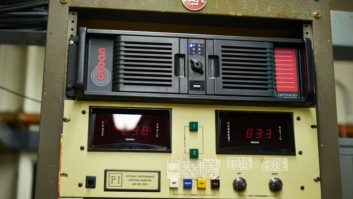A point worth making in digital audio
Aug 1, 2002 12:00 PM, By Kevin Nose’
Digital doesn’t guarantee perfection in the production domain. The way that audio data is processed can actually cause unwanted noise in an aspiringly pristine mix.
The key point to understand in a production environment is that with any desired final dynamic range and signal-to-noise goal, there must be an even greater internal dynamic range and signal-to-noise capacity to make that goal possible. Without it, the numerous round-off errors that are always present from digital signal processing could accumulate to the point where they become audible. So even though 16 bits of resolution go a long way to represent a final mix with 96dB of dynamic range, intermediate stages of the signal chain deserve more.
Consider the following worst-case scenario where the amplitude of one 16-bit signal is being scaled down almost entirely, for instance by 95dB. Ideally the result would maintain all accuracy and support 96+95dB of dynamic range, but that would require a lengthy 32 bits of resolution to correctly represent. The additional 16 bits would have to be added to the bottom, or least-significant side of the sample, for this to work properly. Systems that add additional resolution in this way are making use of fixed-point logic, because each sample has an implicit scale associated with it and each bit in the sample represents a known magnitude. The name comes from the idea that the binary point (the base-2 equivalent of a decimal point) for each sample is fixed to a predefined location. With this added resolution, any round-off errors caused by the scaling process would be too small to influence a final 16-bit output. Because of this benefit it isn’t uncommon to find systems that make use of 40 or more bits of fixed-point resolution per internal audio sample.
Other systems employ floating-point logic to support a large internal dynamic range. These systems associate a second parameter with each sample that defines the scale of that sample. This parameter, called the exponent, can help represent a massive dynamic range (�1,000dB with a 10-bit exponent) in a way that simply isn’t practical with fixed-point logic. Although floating-point logic is flexible, it tends to be computationally expensive and is still largely dependent on the resolution of the original audio sample to maintain good signal-to-noise performance.
However it’s accomplished, through fixed-point or floating-point logic, the bottom line to the user should be that the output audio remains free of unwanted production-related artifacts. This depends on the design of the production tools, not the fact that they’re digital.
Nos� is president of NeoSonic Industries, Cleveland, OH.












